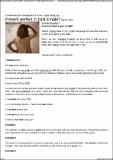Present perfect or past simple?
| dc.contributor.author | Woodford, Kate | |
| dc.date.accessioned | 2014-06-23T18:47:43Z | |
| dc.date.available | 2014-06-23T18:47:43Z | |
| dc.date.issued | 2014-06-23 | |
| dc.identifier.citation | http://dictionaryblog.cambridge.org/2014/04/09/present-perfect-or-past-simple/#more-2810 | en_US |
| dc.identifier.uri | http://hdl.handle.net/123456789/242 | |
| dc.description.abstract | This is a tricky area of the English language for low-level learners, so let’s look again at the rules. When we start studying English, we learn that to talk about an action that started and finished in the past, we use the past simple tense, (for regular verbs, the base verb + -ed) | en_US |
| dc.language.iso | en | en_US |
| dc.publisher | Cambridge Dictionary Blog | en_US |
| dc.subject | English | en_US |
| dc.subject | English Language | en_US |
| dc.title | Present perfect or past simple? | en_US |
| dc.type | Learning Object | en_US |
Files in this item
This item appears in the following Collection(s)
-
Good Reads [48]

